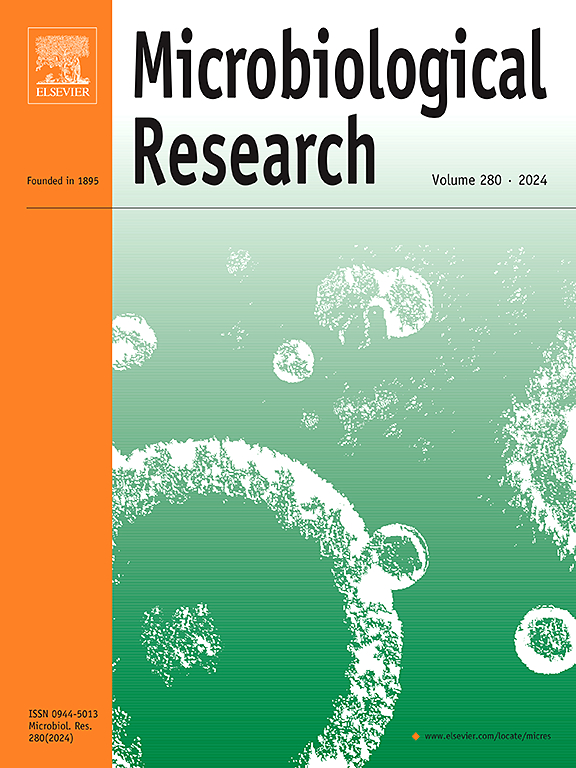Identification and functional characterization of chemoreceptors for phenolic acids in Agrobacterium tumefaciens
IF 6.9
1区 生物学
Q1 MICROBIOLOGY
引用次数: 0
Abstract
Phenolic acids influence host-pathogen interactions and function as key signals in Agrobacterium-mediated transformation or plant-microbe symbiosis. Agrobacterium tumefaciens uses chemotaxis to detect plant-secreted phenolic compounds and migrates to infection sites, though the chemotactic mechanism remains unclear. In this study, starting with structurally simple phenolic acids, the chemotactic response of A. tumefaciens C58 was investigated. The chemotaxis of A. tumefaciens toward 4-hydroxybenzoate and protocatechuate is not impacted by the methyl-accepting chemotaxis proteins (MCPs) Atu0387 and Atu0738, which share a four-helix bundle domain with previously discovered phenolic-sensing MCPs. To identify chemoreceptors for phenolic acids, a heterologous expression and functional screening system was constructed in Escherichia coli. Among the 13 MCPs, Atu0872 could respond to both 4-hydroxybenzoate and protocatechuate. Furthermore, atu0872 deletion weakened chemotaxis toward vanillin, acetosyringone, guaiacol, caffeic, vanillic, salicylic, gallic, p-coumaric, syringic, and sinapinic acids. Although the ligand-binding domain of Atu0872 was predicted to be a nitrate- and nitrite-sensing domain, the A. tumefaciens deletion mutant Δatu0872 did not affect chemotaxis toward nitrate and nitrite. In addition to chemotaxis, atu0872 deletion decreased the tumor weight on Daucus carota roots, Kalanchoe daigremontiana leaves, and the number of bacterial colonies per 0.1 g of tumor, implying that atu0872 affects bacterial colonization on the host by regulating chemotactic behavior. To our knowledge, this is for the first study identifying Atu0872 as a core chemoreceptor in A. tumefaciens for phenolic compounds, providing a theoretical foundation for elucidating the chemotaxis–pathogenicity relationship in A. tumefaciens and optimizing its use in genetic transformations.
农杆菌酚酸化学受体的鉴定及功能表征。
酚酸影响宿主-病原体的相互作用,并在农杆菌介导的转化或植物-微生物共生中作为关键信号发挥作用。农杆菌使用趋化性来检测植物分泌的酚类化合物并迁移到感染部位,尽管趋化机制尚不清楚。本研究从结构简单的酚酸开始,研究了A. tummefaciens C58的趋化反应。a . tummefaciens对4-羟基苯甲酸酯和原儿茶酸酯的趋化性不受甲基接受趋化蛋白(MCPs) Atu0387和Atu0738的影响,它们与先前发现的酚传感MCPs共享一个四螺旋束结构域。为了鉴定酚酸类化学受体,在大肠杆菌中构建了异源表达和功能筛选体系。在13种MCPs中,Atu0872对4-羟基苯甲酸盐和原儿茶酸盐均有应答。此外,atu0872缺失减弱了对香兰素、乙酰丁香酮、愈创木酚、咖啡、香草酸、水杨酸、没食子酸、对香豆酸、丁香酸和辛子酸的趋化性。虽然Atu0872的配体结合结构域被预测为硝酸盐和亚硝酸盐敏感结构域,但a . tummefaciens缺失突变体Δatu0872不影响对硝酸盐和亚硝酸盐的趋化性。除趋化性外,atu0872的缺失还降低了胡萝卜根和甘蓝叶上的肿瘤重量,以及每0.1 g肿瘤的细菌菌落数,这表明atu0872通过调节趋化行为影响细菌在宿主上的定植。据我们所知,这是首次鉴定出Atu0872为肿瘤拟南刀菌中酚类化合物的核心化学受体,为阐明肿瘤拟南刀菌的趋化-致病性关系以及优化其在遗传转化中的应用提供了理论基础。
本文章由计算机程序翻译,如有差异,请以英文原文为准。
求助全文
约1分钟内获得全文
求助全文
来源期刊

Microbiological research
生物-微生物学
CiteScore
10.90
自引率
6.00%
发文量
249
审稿时长
29 days
期刊介绍:
Microbiological Research is devoted to publishing reports on prokaryotic and eukaryotic microorganisms such as yeasts, fungi, bacteria, archaea, and protozoa. Research on interactions between pathogenic microorganisms and their environment or hosts are also covered.
 求助内容:
求助内容: 应助结果提醒方式:
应助结果提醒方式:


